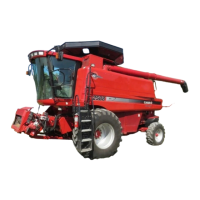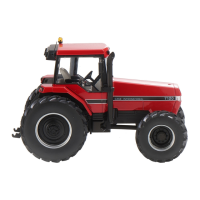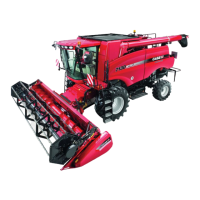30
AFS
Grain Moisture and Weight Calibration (cont.)
• If moisture readings are consistently very low, the auger may
be operating constantly, preventing grain contact with the
fin. (Likely to occur only in lower yield crop where the bypass
auger removes grain from the bypass as quickly as
it enters).
• Your Case IH dealer should be consulted to correct
the condition
• If moisture readings are consistent, but at a value more
likely to be representative of actual grain moisture content,
the auger may not be operating
• The sensor is merely providing a moisture reading of a static
sample that is in the bypass housing
The bypass auger is controlled by a proximity switch that
cycles the auger as required, to assure the sensor fin is always
in contact with grain.
• The auger should operate for 30 seconds after the separator
is disengaged, to clean grain from the bypass. Auger
operation can be checked by visually watching the end of
the auger shaft during this 30 second period, to see if the
shaft is turning.
• If not, check to assure the moisture sensor bypass auger
use is not blown. If the fuse is not at fault, contact your
Case IH dealer for assistance.
Operators must also remember that adjustment or replacement of
any component that affects calibration requires re-calibration.
• Memory management features of AFS allows operators to
apply calibration values to specific loads, or beginning at a
specific time during harvest, such as the time when
component replacement occurred.
• Refer to the Operator’s Manual after re-calibration to use the
correct Utility menu to apply calibration to the correct
harvest data.
To record harvest data, four criteria must be met.
• A memory card must be inserted in the top slot of the
display before turning the power ON. The card should have
only ONE *.yld file or ONE *.cnh folder. Use Windows
Explorer to confirm.
• The clean grain elevator must be running between 250 and
599 RPM
• Ground speed must be registered
• The header must be lowered below the header cut “stop
height” position
When data is being recorded, the “REC” indicator on the
display will be darkened.
In understanding the calibration process, the operator realizes
the importance of maintaining an accurate record of the
calibration load weight and moisture test results, as well as
load identification.
• Identification is necessary to enter a load name into AFS,
as well as on scale tickets. The operator should anticipate
the need for load names, and can actually enter load names
prior to harvest.
See the calibration record table included in the
AFS Operator’s Manual or
(see table 30.1).
Crop Type: Date:
Combine: Operator
Field Load
Flow
Bu/Hr
Estimated
Weight
Actual
Weight
%
Error
Include?
(Y/N)
1
Cal
1Hi
2
Cal
2Hi
3
Cal
1
Med
4
Cal
2
Med
5
Cal
1Lo
6
Cal
2Lo
7
Table 30.1

